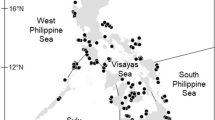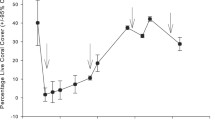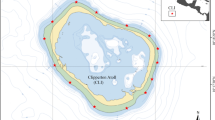Abstract
Juvenile coral abundance and community composition depend on the spatial scale studied. To investigate this, an evaluation was made of juvenile coral density with hierarchical spatial analysis in the northern Mesoamerican Barrier Reef System (MBRS) at ~10 m depth. Study scope included semi-protected and unprotected areas located in this region. A total of 19 juvenile coral taxa were found, including 10 scleractinian species, 8 scleractinian coral genera not identified to species, and 1 Millepora species (Hydrozoa-Milleporidae). In terms of relative abundance, Agaricia spp., Siderastrea spp., and Porites spp. were the main juvenile taxa in the coral community at the surveyed sites, reefs, and regions levels. Greater variance was seen at smaller scales, at site level for taxa richness, and at the transect level for juvenile density, and lower variance was seen at larger scales (reefs and regions). The variance component contribution from each scale likely differed from other studies because of the different factors affecting the community and the different extensions of each scale used in each study. Densities (1–6.4 juvenile corals/m2) and dominant taxa found in this study agree with other studies from the Western Atlantic. Detected variability was explained by different causal agents, such as low grazing rates by herbivorous organisms, turbidity, and/or sediment suffocation and some nearby or distant localized disturbance (human settlement and a hurricane).






Similar content being viewed by others
References
AGRRA database (2003) Atlantic and Gulf Rapid Reef Assessment (AGRRA) Database, Surveys: 1997 – 2000, January 2003, Version 1. CD-ROM
Angel MV (1995) Spatial distribution of marine organisms: patterns and processes. In: Edwards PJ, May RM, Webb NR (eds) Large-scale ecology and conservation biology. Blackwell Science, Oxford, pp 59–109
Ault TR, Johnson CR (1998) Spatially and temporally predictable fish communities on coral reefs. Ecol Monogr 68(1):25–50
Babcock R, Mundy C (1996) Coral recruitment: consequences of settlement choice for early growth and survivorship in two scleractinians. J Exp Mar Biol Ecol 206:179–201
Baird AH, Hughes TP (1997) Spatial variation in coral recruitment around Lizard Island, Australia. Proc 8th Int Coral Reef Sym, 2, pp 1207–1210
Bak RPM, Engel MS (1979) Distribution, abundance, and survival of juvenile hermatypic corals (Scleractinia) and the importance of life history strategies in the parent coral community. Mar Biol 54:341–352
Birkeland C (1977) The importance of rate of biomass accumulation in early successional stages of benthic communities to the survival of coral recruits. Proc Third Int Coral Reef Symp, pp 15–21
Birkeland C, Rowley D, Randall RH (1981) Coral recruitment patterns at Guam. Proc 4th Int Coral Reef Symp, 2, pp 339–344
Carlon DB, Olson RR (1993) Larval dispersal distance as an explanation for adult spatial pattern in two Caribbean reef corals. J Exp Mar Biol Ecol 173:247–263
Caselle JE, Warner RR (1996) Variability in recruitment of coral reef fishes: the importance of habitat at two spatial scales. Ecology 77(8):2488–2504
Chiappone M, Sullivan KM (1996) Distribution, abundance and species composition of juvenile scleractinian corals in the Florida reef tract. Bull Mar Sci 58(2):555–569
Cornell HV, Karlson RH (2000) Coral species richness: ecological versus biogeographical influences. Coral reefs 19:37–49
Crabbe MJC, Mendes JM, Warner GF (2002) Lack of recruitment of non-branching corals in Discovery Bay is linked to severe storms. Bull Mar Sci 70(3):939–945
Dubinsky Z, Stambler N (1996) Marine pollution and coral reefs. Glob Change Biol 2:511–526
Dustan PK, Johnson CR (1998) Spatio-temporal variation in coral recruitment at different scales on Heron Reef, southern Great Barrier Reef. Coral Reefs 17:71–81
Edmunds PJ (2000a) Recruitment of scleractinians onto the skeletons of corals killed by black band disease. Coral reefs 19:69–74
Edmunds PJ (2000b) Patterns in the distribution of juvenile corals and coral reef community structure in St. John, US Virgin Island. Mar Ecol Prog Ser 202:113–124
Edmunds PJ, Bruno JF (1996) The importance of sampling scale in ecology: kilometer-wide variation in coral reef communities. Mar Ecol Prog Ser 143:165–171
Edmunds PJ, Carpenter RC (2001) Recovery of Diadema antillarum reduces macroalgal cover on a Caribbean reef. PNAS 98(9):5067–5071
Edmunds PJ, Aronson RB, Swanson DW, Levitan DR, Precht WF (1998) Photographic versus visual census techniques for the quantification of juvenile corals. Bull Mar Sci 62(3):937–946
Fabricius KE, Wolanski E (2000) Rapid smothering of coral reef organisms by muddy marine snow. Estuar Coast Shelf S 50:115–120
Fearon RJ, Cameron AM (1997) Preliminary evidence supporting the ability of hermatypic corals to affect adversely larvae and early settlement stages of hard coral competitors. J Chem Ecol 23(7):1769–1780
Fowler AJ, Doherty PJ, Williams DMcB (1992) Multi-scale analysis of recruitment of a coral reef fish on the Great Barrier Reef. Mar Ecol Prog Ser 82:131–141
Gutiérrez Carbonell D, García Sáez C, Lara Pérez Soto M, Padilla Souza C, Pizaña Alonso J, Macias Ordoñez R (1993) Caracterización de los arrecifes coralinos de la Reserva de la Biosfera de Sian Ka’an, Q. Roo. Sian Ka’an Serie de Documentos (1):1–47
Gilmour J (1999) Experimental investigation into the effects of suspended sediment on fertilization, larval survival and settlement in a scleractinian coral. Mar Biol 135:451–462
Goreau NI, Goreau TJ, Hayes RL (1981) Settling, survivorship and spatial aggregation in planulae and juveniles of the coral Porites porites. Bull Mar Sci 31(2):424–435
Hadfield MG (1986) Settlement and recruitment of marine invertebrates: a perspective and some proposals. Bull Mar Sci 39:418–425
Harrison PL, Wallace CC (1990). Reproduction, dispersal and recruitment of scleractinian corals. In: Dubinsky Z (ed) Ecosystems of the world. Coral reefs. Elsevier, Amsterdam, pp 133–207
Hodgson G (1990) Sediment and the settlement of larvae of the reef coral Pocillopora damicornis. Coral Reefs 9:41–43
Hughes TP, Connell JH (1999) Multiple stressors on coral reefs: A long-term perspective. Limnol Oceanogr 44(3, part 2):932–940
Hughes TP, Baird AH, Dinsdale EA, Moltschaniwskyj NA, Pratchett MS, Tanner JE, Willis BL (1999) Patterns of recruitment and abundance of corals along the Great Barrier Reef. Nature 397:59–63
Hughes TP, Baird AH, Dinsdale EA, Moltschaniwskyj NA, Pratchett MS, Tanner JE, Willis BL (2000) Supply-side ecology works both ways: the link between benthic adults, fecundity, and larval recruits. Ecology 81(8):2241–2249
INEGI (1996) Quintana Roo conteo de población y vivienda 1995, resultados definitivos tabulados básicos. Instituto Nacional de Estadística Geografía e Informática, México, 219 pp
Jordán-Dahlgren E (1992) Recolonization patterns of Acropora palmata in a marginal environment. Bull Mar Sci 51(1):104–117
Legendre P, Fortin MJ (1989) Spatial pattern and ecological analysis. Vegetatio 80:107–138
Legendre P, Legendre L (1998) Numerical Ecology. Elsevier, Amsterdam, 853 pp
Lewis JB (1974) The settlement behaviour of planulae larvae of the hermatypic coral Favia fragum (Esper). J Exp Mar Biol Ecol 15:165–172
Maida M, Coll JC, Sammarco PW (1994) Shedding new light on scleractinian coral recruitment. J Exp Mar Biol Ecol 180:189–202
Miller MW, Weil E, Szmant AM (2000) Coral recruitment and juvenile mortality as structuring factors for reef benthic communities in Biscayne National Park, USA. Coral Reefs 19:115–123
Morse DE, Hooker N, Morse ANC, Jensen RA (1988) Control of larval metamorphosis and recruitment in sympatric agariciid corals. J Exp Mar Biol Ecol 116:193–217
Morse DE, Morse ANC, Raimondi PT, Hooker N (1994) Mphogen-based chemical flypaper for Agaricia humilis coral larvae. Biol Bull 186:172–181
Mumby PJ (1999a) Bleaching and hurricane disturbances to populations of coral recruits in Belize. Mar Ecol Prog Ser 190:27–35
Mumby PJ (1999b) Can Caribbean coral populations be modelled at metapopulation scales? Mar Ecol Prog Ser 180:275–288
Murdoch TJT, Aronson RB (1999) Scale-dependent spatial variability of coral assemblages along the Florida Reef Tract. Coral Reefs 18:341–351
Ninio R, Meekan M, Done T, Sweatman H (2000) Temporal patterns in coral assemblages on the Great Barrier Reef from local to large spatial scales. Mar Ecol Prog Ser 194:65–74
Nuñez-Lara E, González-Salas C, Ruiz-Zárate MA, Hernández-Landa R, Arias-González JE (2003) Condition of coral reef ecosystems in central-southern Quintana Roo (Part 2: Ref. fish communities). In: Lang JC (ed) Status of Coral Reefs in the western Atlantic: Results of initial Surveys, Atlantic and Gulf Rapid Reef Assessment (AGRRA) Program. Atoll Research Bulletin 496:338–358
Oxley WG (1997) Sampling design and monitoring. In: English S, Wilkinson C, Baker V (eds) Survey manual for tropical marine resources, 2nd edition. Australian Institute of Marine Science, pp 307–320
Pandolfi JM (2002) Coral community dynamics at multiple scales. Coral Reefs 21:13–23
Pastorok RA, Bilyard G (1985) Effects of sewage pollution on coral-reef communities. Mar Ecol Prog Ser 21:175–189
Pearson RG (1981) Recovery and recolonization of coral reefs. Mar Ecol Prog Ser 4:105–122
Richards Kramer P, Lang JC (2003) Appendix one. The Atlantic and Gulf Rapid Reef Assessment (AGRRA) Protocols: Former (version 2.2). In: Lang JC (ed) Status of Coral Reefs in the western Atlantic: Results of Initial Surveys, Atlantic and Gulf Rapid Reef Assessment (AGRRA) Program. Atoll Research Bulletin 496:611–624
Richmond RH (1997) Reproduction and recruitment in corals: Critical links in the persistence of reefs. In: Birkeland C (ed) Life and death of coral reefs. Chapman and Hall, pp 175–197
Rogers CS (1990) Responses of coral reefs and reef organisms to sedimentation. Mar Ecol Prog Ser 62:185–202
Rogers CS, Fitz HC III, Gilnack M, Beets J, Hardin J (1984) Scleractinian coral recruitment patterns at Salt River submarine canyon, St. Croix, U.S. Virgin Islands. Coral Reefs 3:69–76
Ruiz-Zárate MA, Espinoza-Avalos J, Carricart-Ganivet JP, Fragoso D (2000) Relationships between Manicina areolata (Cnidaria: Scleractinia), Thalassia testudinum (Anthophyta) and Neogoniolithon sp. (Rhodophyta). Mar Ecol Prog Ser 206:135–146
Ruiz-Zárate MA, Hernández-Landa RC, González-Salas C, Núñez-Lara E, Arias-González JE (2003) Condition of coral reef ecosystems in central-southern Quintana Roo, Mexico (Part 1: stony corals and algae). In: Lang JC (ed) Status of Coral Reefs in the western Atlantic: Results of Initial Surveys, Atlantic and Gulf Rapid Reef Assessment (AGRRA) Program. Atoll Research Bulletin 496:318–337
Rylaarsdam KW (1983) Life histories and abundance patterns of colonial corals on Jamaican reefs. Mar Ecol Prog Ser 13:249–260
Sale PF (1998) Appropriate spatial scales for studies of reef-fish ecology. Aust J Ecol 23:202–208
Sale PF (1999) Recruitment in space and time. Nature 397:25–27
Sammarco (1994) Larval dispersal and recruitment processes in Great Barrier Reef corals: Analysis and synthesis. In: Sammarco PW, Heron ML (eds) The Bio-Physics of marine larval dispersal. American Geophysical Union, Washington, DC, pp 35–72
Smith SR (1992) Patterns of coral recruitment and post-settlement mortality on Bermuda’s reefs: Comparisons to Caribbean and Pacific reefs. Am Zool 32:663–673
Smith SR (1997) Patterns of coral settlement, recruitment and juvenile mortality with depth at Conch Reef, Florida. Proc 8th Int Coral Reef Sym, 2, pp 1197–1202
Sokal RR, Rohlf FJ (1995) Biometry: the principles and practice of statistics in biological research, 3rd edition. WH Freeman and Company, New York, 887 pp
Sullivan MC, Cowen RK, Able KW, Fahay MP (2000) Spatial scaling of recruitment in four continental shelf fishes. Mar Ecol Prog Ser 207:141–154
Underwood AJ (1997) Experiments in Ecology: Their logical design and interpretation using analysis of variance. Cambridge University Press, Cambridge, 504 pp
Van Woesik R (2000) Modelling processes that generate and maintain coral community diversity. Biodiversity and Conservation 9:1219–1233
Wells SM (1995) Science and management of coral reefs: Problems and prospects. Coral Reefs 14:177–181
Wittenberg M, Hunte W (1992) Effects of eutrophication and sedimentation on juvenile corals. I. Abundance, mortality and community structure. Marine Biology 112:131–138
Acknowledgements
The authors would like to thank R. Hernández-Landa, C. González-Salas, and E. Nuñez-Lara for their help with the fieldwork, and the staffs of the Sian Ka’an Biosphere Reserve, SEMARNAP Quintana Roo, and Amigos de Sian Ka’an for use of their facilities. Thanks are also due Dr. Terry Hughes, Dr. Peter Sale, Dr. Pierre Legendre and two anonymous reviewers for their helpful commentaries on this paper. This research was partially financed by UNEP, AGRRA, CONACYT (28386-N) and CINVESTAV. M.A. Ruiz-Zárate received funding from CONACYT (grant 129322).
Author information
Authors and Affiliations
Corresponding author
Additional information
Communicated by: Ecological Editor Peter Sale
Rights and permissions
About this article
Cite this article
Ruiz-Zárate, M.A., Arias-González, J.E. Spatial study of juvenile corals in the Northern region of the Mesoamerican Barrier Reef System (MBRS). Coral Reefs 23, 584–594 (2004). https://doi.org/10.1007/s00338-004-0420-z
Received:
Accepted:
Published:
Issue Date:
DOI: https://doi.org/10.1007/s00338-004-0420-z




